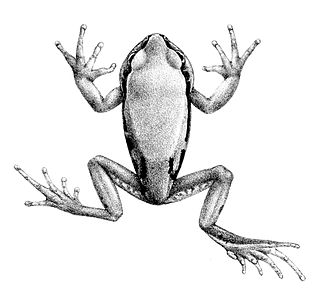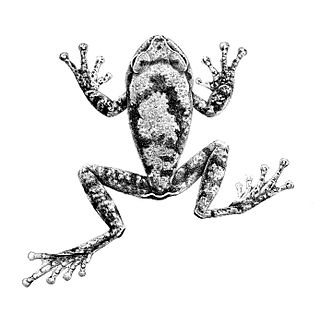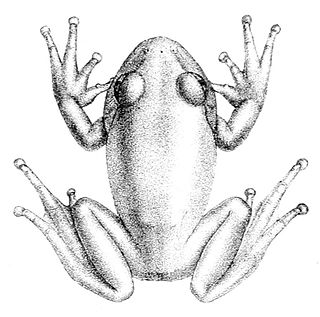
Leptopelis is a genus of frogs in the family Arthroleptidae. They are found throughout Sub-Saharan Africa, excluding Madagascar. It is placed in monotypic subfamily Leptopelinae, although this subfamily is not always recognized. They have a number of common names, including forest treefrogs, tree frogs, leaf-frogs, and big-eyed frogs.
Leptopelis boulengeri is a species of frog in the family Arthroleptidae. It is found in southeastern Nigeria, southern Cameroon, Equatorial Guinea, Gabon, Republic of the Congo, and western Democratic Republic of the Congo. It is expected to be found in the Central African Republic and the Cabinda Enclave of Angola. Common name Victoria forest treefrog has been coined for it, apparently in reference to its type locality, "Victoria, Kamerun", now known as Limbe.
Leptopelis fiziensis, also known as the Mokanga forest tree frog or Fizi tree frog, is a species of frog in the family Arthroleptidae. It is known from the Democratic Republic of the Congo and Tanzania, on both sides of Lake Tanganyika, and it is likely to occur in Burundi, in between the two know areas of distribution.

Leptopelis flavomaculatus is a species of frog in the family Arthroleptidae. It is found in the lowlands eastern and southern Africa, from Mozambique north of the Save River and Zimbabwe to Malawi, eastern Tanzania, and coastal Kenya. Its common names are yellow-spotted tree frog, brown-backed tree frog, brown forest treefrog, and Johnston's treefrog.

Leptopelis gramineus is a species of frog in the family Arthroleptidae. It is endemic to Ethiopia and occurs on the Ethiopian Highlands on both sides of the Great Rift Valley. Common names Badditu forest treefrog and Ethiopian burrowing tree frog have been coined for it.

Leptopelis kivuensis is a species of frog in the family Arthroleptidae. It is found in the highlands of western Burundi, Rwanda, and Uganda, and in the extreme eastern Democratic Republic of the Congo. It has been considered synonym of Leptopelis karissimbensis, and has been confused with that species. Common names Kisenyi forest treefrog and Kivu tree frog have been coined for it.
Leptopelis modestus is a species of frog in the family Arthroleptidae. Its common names are modest forest treefrog and plain tree frog.
Leptopelis nordequatorialis, also known as the West Cameroon forest treefrog, is a species of frog in the family Arthroleptidae. It is found in central and western Cameroon and eastern Nigeria. It is closely related to Leptopelis anchietae and Leptopelis oryi.
Leptopelis oryi, also known as the Garamba forest treefrog and Ory's tree frog, is a species of frog in the family Arthroleptidae. It is found in the northeastern Democratic Republic of the Congo, northwestern Uganda, and adjacent South Sudan. It is morphologically similar to Leptopelis nordequatorialis from Cameroon, and has also been considered its synonym, but is currently treated as a distinct species. The specific name oryi honours Albert Ory, warden in the Garamba National Park, the type locality of this species.

Leptopelis parkeri is a species of frog in the family Arthroleptidae. It is endemic to Tanzania and known from the Eastern Arc Mountains. Specifically, it has been recorded from Uluguru, Udzungwa, East and West Usambara, Nguru, and South Pare Mountains. Common names Parker's tree frog and Parker's forest treefrog have been coined for it. It is named after Hampton Wildman Parker, a British zoologist and herpetologist from the Natural History Museum, London.
Leptopelis ragazzii is a species of frog in the family Arthroleptidae. The species is endemic to the Ethiopian Highlands on both sides of the Great Rift Valley. Common names Ragazzi's tree frog and Shoa forest treefrog have been coined for it. It is named after Vincenzo Ragazzi (1856–1929), from the Modena Natural History Society, who explored and collected in Ethiopia.

Leptopelis vannutellii is a species of frog in the family Arthroleptidae. It is endemic to the highlands of southwestern Ethiopia. Common names Vannutelli's tree frog and Dime forest treefrog have been coined for it. It is named after Leonardo Vannutelli, Italian navy officer who joined Vittorio Bottego's second expedition to East Africa.

Leptopelis viridis is a species of frog in the family Arthroleptidae. It is widely distributed in the West and Central African savanna zone between Senegal and the Gambia to the northeastern Democratic Republic of Congo.
Leptopelis yaldeni is a species of frog in the family Arthroleptidae. It is endemic to Ethiopia and occurs in the montane highlands in Gojjam. Its range might be limited by the deep gorges of the Blue Nile. It is named in honour of Derek Yalden, a British zoologist who collected some of the types. Common names Yalden's tree frog and grassland forest treefrog have been coined for this species.
Phrynobatrachus inexpectatus is a species of frog in the family Phrynobatrachidae. It is endemic to southern Ethiopia. It is known with confidence from only three localities, but it may be more widely distributed in the Ethiopian Highlands. The specific name inexpectatus refers to the unexpected discovery of this species among museum specimens assigned to Phrynobatrachus minutus. Common names unexpected puddle frog and Largen's dwarf puddle frog have been coined for it.
Platymantis isarog, sometimes known as the Isarog forest frog, is a species of frog in the family Ceratobatrachidae. It is endemic to southeastern Luzon, Philippines, where it is known from two volcanos, Mount Isarog and Mount Malinao.
Ptychadena harenna is a species of frog in the family Ptychadenidae. It is endemic to Ethiopia and only known from its type locality at the foothills of the Bale Mountains, in the Bale Mountains National Park. The locality is within the Harenna Forest, and common name Harenna Forest grass frog has been coined for it.
Ptychadena wadei is a species of frog in the family Ptychadenidae. It is endemic to Ethiopia and only known from a small area southeast of Lake Tana, in the upper reaches of the Blue Nile. The specific name wadei honours Edward O.Z. Wade, an English illustrator and herpetology enthusiast who drew some of the illustrations accompanying the species description. Common name Wade's grass frog has been coined for it.

Leptopelis spiritusnoctis is a species of frog in the family Arthroleptidae. It is found in West Africa from Guinea to the Niger Delta in Nigeria, the intervening countries being Sierra Leone, Liberia, Ivory Coast, Ghana, Togo, and Benin. This species was previously known as Leptopelis hyloides, but that name is actually a junior synonym of Leptopelis viridis.
Leptopelis anebos, the young Itombwe forest treefrog, is a frog in the genus Leptopelis found in the Democratic Republic of the Congo and Congo. The young Itombwe forest treefrog was scientifically described in 2014 by Portillo & Greenbaum. It's morphologically similar to L. modestus and L. karissimbensis.








